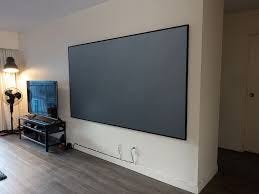Projector Screen vs. TV: Which Is Best for Bright Rooms?

When setting up a home theater or an entertainment space, one of the biggest decisions you’ll face is whether to go with a projector screen or a TV. This decision becomes even more crucial in bright rooms, where ambient light can affect image clarity and overall viewing experience. While traditional TVs have been the go-to option for many, advancements in projection technology — especially with ceiling light rejecting projector screens — have made projectors a viable and often superior choice for bright spaces.
In this blog, we’ll compare projectors and TVs, discuss the benefits of using ceiling light rejecting projector screens, and highlight why Elite Screens is a top brand for this setup.
Understanding the Challenge of Bright Rooms
Bright rooms with natural sunlight or artificial ceiling lighting can significantly impact your viewing experience. High ambient light can wash out images on standard projector screens, making them less vibrant and reducing contrast. Similarly, TVs, although known for their brightness, may produce glare that can make it difficult to see images clearly.
This is where ceiling light rejecting projector screens come into play. Unlike traditional projector screens, these specialized screens are designed to reject overhead ambient light, ensuring sharp and bright images even in well-lit environments.
Projector Screens vs. TVs: A Detailed Comparison
1. Brightness and Picture Quality
- TVs: Modern LED, OLED, and QLED TVs offer excellent brightness levels and can handle high ambient light conditions. However, screen glare from direct lighting or windows can be a major drawback.
- Projector Screens: Traditional projector screens struggle in bright conditions, but a ceiling light rejecting projector screen (such as Elite Screens’ Aeon CLR® series) enhances contrast and brightness, making it a better option for well-lit spaces.
2. Screen Size and Viewing Experience
- TVs: The largest consumer-grade TVs available are around 85–100 inches, and they come at a high price.
- Projector Screens: Projectors can create much larger images, often exceeding 120 inches at a fraction of the cost. A ceiling light rejecting projector screen allows for a cinematic experience without the drawbacks of traditional projection setups.
3. Cost and Value for Money
- TVs: High-end OLED and QLED TVs can be extremely expensive, especially in sizes above 75 inches.
- Projector Screens: A high-quality projector combined with a ceiling light rejecting projector screen is often more cost-effective than purchasing a giant TV. Brands like Elite Screens offer affordable yet high-performance screens that enhance image clarity in bright environments.
4. Installation and Space Requirements
- TVs: TVs are relatively easy to install but are bulky, limiting placement options.
- Projector Screens: Projectors require a screen and mounting, but a retractable ceiling light rejecting projector screen can be hidden when not in use, making it a more flexible solution.
5. Glare and Reflection Issues
- TVs: Bright room settings often cause screen glare, making it challenging to watch from different angles.
- Projector Screens: With a ceiling light rejecting projector screen, ambient overhead lighting is absorbed rather than reflected, reducing glare and improving picture quality.
Why Choose a Ceiling Light Rejecting Projector Screen?
A ceiling light rejecting projector screen is specially engineered to combat ambient lighting, ensuring deep blacks, enhanced contrast, and vibrant colors. Here’s why it’s the perfect choice for bright rooms:
- Ambient Light Rejection (ALR): These screens are designed to reject unwanted light from the ceiling while maximizing the brightness of projected images.
- Superior Contrast: Even in well-lit environments, images appear crisp and detailed.
- Large Screen Experience: Unlike TVs, projector screens can provide massive image sizes without excessive cost.
- Flexible Installation: They can be wall-mounted, ceiling-mounted, or retractable for versatile placement options.
Recommended Ceiling Light Rejecting Projector Screen: Elite Screens
If you’re considering a ceiling light rejecting projector screen, Elite Screens is a brand you should look at. Known for their innovation and affordability, they offer some of the best ALR screens on the market.
Elite Screens Aeon CLR® Series
- Features a Ceiling Light Rejecting (CLR®) material that eliminates washout from overhead lights.
- Ultra-wide viewing angles ensure the entire room gets a great view.
- Available in various sizes up to 120 inches.
- High contrast and color accuracy for an immersive experience.
Other top models from Elite Screens include:
- CineGrey 5D®: A great option for both bright and dim rooms.
- StarBright CLR®: Specifically designed for ultra-short-throw (UST) projectors.
Secondary Keywords to Consider
To further enhance your research and decision-making, here are some secondary keywords related to ceiling light rejecting projector screens:
- Ambient light rejecting projector screen
- Best projector screen for bright rooms
- Home theater projector screen
- Ultra-short throw projector screen
- Elite Screens projector
- Best ALR projector screen for daylight
Final Verdict: Projector Screen or TV?
For bright rooms, a ceiling light rejecting projector screen is the best option for achieving a cinematic experience without sacrificing image quality. While TVs provide high brightness, they often suffer from glare and size limitations. In contrast, a high-quality Elite Screens ALR projector screen can deliver a massive, glare-free, high-contrast image at a more affordable price.
If you want the best viewing experience in a bright room, go for a ceiling light rejecting projector screen — and for top-notch quality, choose Elite Screens!
Source:"https://medium.com/@elitescreeninc/projector-screen-vs-tv-which-is-best-for-bright-rooms-095f8d129056"



Comments
Post a Comment